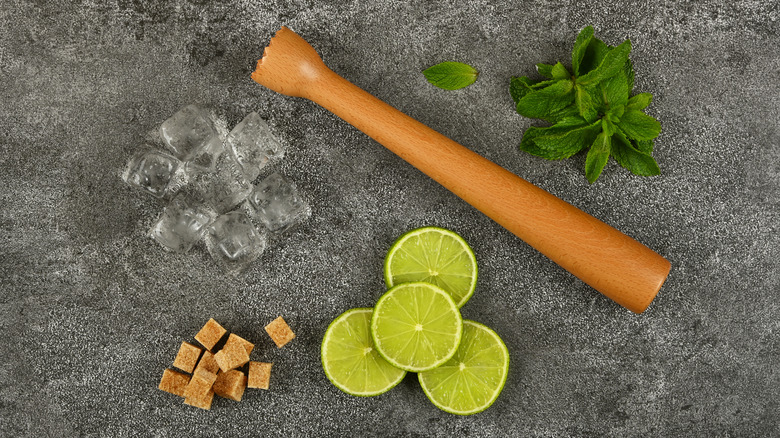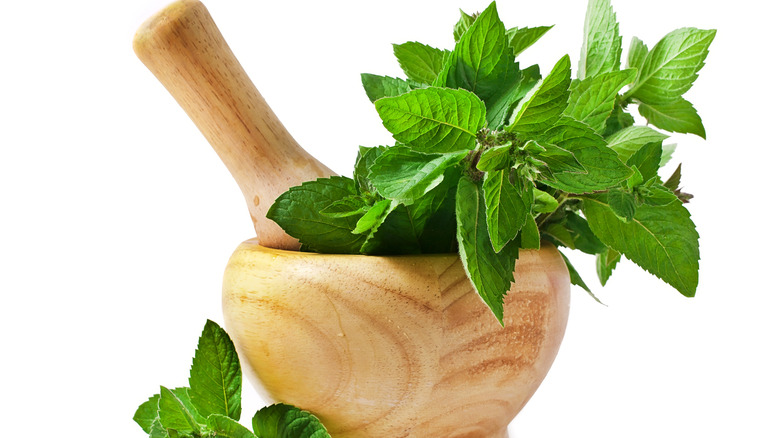You Don't Need A Muddler To Properly Break Down Mint
Merriam-Webster equates a muddler to a "fumbler" or "bumbler," but the culinary world fortunately has a much kinder take on that long, skinny implement tucked inside countless kitchen drawers. It's likely underutilized in everyday life, but when you do need a muddler, it suddenly becomes essential. We know its kitchen cousin, the pestle, can grind herbs and whole spices, smash fruits, or quickly cream an avocado. So, with similar attributes to the pestle, why do we need a separate muddler?
As it turns out, maybe we don't. A muddler is strongly tied to making cocktails for both home and professional use. It's usually long and thin to reach the bottom of a cocktail glass, and it can have either a rounded end or one that's flat and toothed. The goal is to break down or grind ingredients, including delicate ones like mint leaves, a common component of beloved cocktails such as mojitos and mint juleps.
A muddler also helps blend several ingredients together in the glass. With a traditional Cuban mojito, that would be fresh mint leaves, lime slices, and sugar before adding the rum later. So the muddler must be strong enough to juice the limes, yet delicate enough to avoid breaking the glass or ruining the delicate leaves. That seems a tall order for a single bar tool, but in reality, quite a few common kitchen items can do the job in a pinch. Think of a wooden mixing spoon, mortar and pestle, meat pounder, or a wooden mallet.
Repurpose ordinary items for muddling cocktails
When substituting mundane cooking implements for a cocktail muddler, you'll typically be using the handle more than the base. That's especially true when muddling straight into the glass. That's why the long, rounded wooden or bamboo handles of mixing spoons are ideal options. Steel, plastic, or hard spoons potentially work as well, but it's best to avoid ones with "teethy" or square ends, since fresh herbs are delicate, particularly mint leaves. The intricate veins in each mint leaf harbor chlorophyll, which, when crushed with excessive impact, can impart a bitter, grassy taste to your drink.
For wooden rolling pins, use the handle tips on either side to gently press and twist the ingredients. However, since the middle portion of a roller is generally much thicker than the handles, this only works for sturdy wide-mouthed cocktail glasses or, even better, a copper cocktail mug. A wooden meat pounder has an extra added benefit: When turning it upside down to muddle with the handle end, you can firmly grasp the chunky mallet and control the pressure.
Finally, there's the common go-to kitchen tool, a mortar and pestle. Chefs routinely use it for a variety of muddling needs, and the pestle portion already bears the necessary shape for cocktail muddling. But it's typically much shorter and thicker, so you may need to muddle ingredients outside the cocktail glass. To avoid lingering spice or fruit aromas from previous use, consider muddling with the pestle's handle rather than the usual base.
Materials and coatings matter
Whether using an existing muddler or a handy substitute, there are a few things to consider, specifically regarding materials. When it's going into your cocktail glass, and ultimately into your body, the material and coating on any muddling tool matters.
Wood is a first choice for many chefs, but when muddling something as delicate as mint and other herbs, avoid wood that's varnished, painted, or lacquered. All those coatings will wear down with extended use, and you don't want any residual bits making their way into your mojito, mint julep, Moscow mule, or mint margarita.
Another consideration with wood is the potential for bacteria to thrive in crevices and on surfaces. That bacteria and mold could transfer from a muddler or pestle to your drink, but also onto your hands, contaminating anything you touch. Specifically when repurposing a tool such as a meat pounder or rolling pin, take care to wash it thoroughly and pat it dry after each use. Similarly, avoid cleaning it in the dishwasher. Just before muddling, give it another quick scrub for extra safety.
Stainless steel makes a big presence in professional cocktail muddling, with its durability, easy maintenance, and sleek visual appeal. It's easy to clean and generally withstands the strong water power and detergents of a dishwasher. If the tip is grated or textured rather than round, remove any bits of mint, sugar, or fruit that may accumulate.



